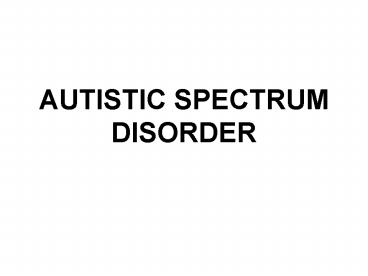AUTISTIC SPECTRUM DISORDER - PowerPoint PPT Presentation
1 / 17
Title:
AUTISTIC SPECTRUM DISORDER
Description:
a result of an emotional disorder. a mental illness ... Echolalia repeating words but not responding to their meaning. Pronoun reversal ... – PowerPoint PPT presentation
Number of Views:97
Avg rating:3.0/5.0
Title: AUTISTIC SPECTRUM DISORDER
1
AUTISTIC SPECTRUM DISORDER
2
Autistic Spectrum Disorder
- IS NOT
- a result of parent rejection
- a result of an emotional disorder
- a mental illness
- genius some have special skills- most do not
- curable
3
Autistic Spectrum Disorder
- IS
- a development disorder
- more common in males than females
- A life long disability
4
- In order to be diagnosed with autism, a person
has to have deficits in three distinct areas. - When all three deficits are present, this is
termed - - The Triad of Autistic Impairment
5
Triad of Autistic Impairment
Impairment of language and communication
Impairment of social interaction
Impairment of flexibility of thought and
behaviour
6
Autism Affects the Understanding of Common
Phrases, Idioms or Metaphors
- Has the cat got your tongue?
- Takes two seconds to say, but could cause a
lifetime of fear. - Heres your change
- Im not going to change.
7
- A diagnostic label of autism alerts us to the
fact that a person has a different way of
thinking and interacting with their environment. - Not all the recognised features of autism sill be
found in all people with ASD, but some of the
following features will be present .
8
Impairment of Communication
- No shared attention
- Inappropriate eye-contact
- Lack of communicative intent
- Echolalia repeating words but not responding to
their meaning - Pronoun reversal
- Use of odd intonation and lack of understanding
of the meaning that the intonation pattern
conveys - Restricted vocabulary e.g. collection of rhymes
or jingles, text in a book or video - Inappropriate communication to social content
- Literalism taking words literally no
metaphorical interpretation
9
Other Features of Language Impairment in People
with ASD
- Problems with attention
- Poor auditory skills
- Difficulty with sequencing in all areas
- Lack of understanding, cause and effect
- Difficulty predicting outcomes
- Obsessional and stereotypical speech
10
Impairment of Social Interaction
- a lack of attention to people
- treating people as inanimate objects
- not responding when addressed in a group
- needing personal space, but not understanding
that others need personal space - little comprehension of emotions
- inability to interact with others
11
Further Features of Social Impairment
- can make personal comments without understanding
that this may cause offence - expects other people to know their thoughts and
feeling - response to peer pressure can range from
indifference to total over-reaction - expressions of emotion often inappropriately
extreme
12
Impairment of flexibility of thought and
behaviour - continued
- narrow interests or obsessions which the child
may demand to repeat over and over again, however
difficult or inconvenient to parents and tutors. - rigidity difficulties with change/having to get
to the end - unusual coping mechanisms to cope with anxiety
e.g. obsessive drawing, flapping, making noises,
repetitive questioning.
13
Impairment of Flexibility of Thought and Behaviour
- theory of mind- inability to see someone elses
point of view - central coherence seeing the individual trees
and not the whole forest - literalism
- difficulty with generalisation
- difficulty with problem-solving
- difficulty in creating something entirely from
their imagination
14
Skills Required For Learning Are Affected
15
Other Features Associated with Autism
- motor stereotypes such as handflapping, flicking
fingers in front of eyes, toe-walking - self-injurious behaviour
- erratic patterns of eating or drinking eating
inappropriate substances. - epilepsy
- hyperactivity
16
- The autistic child is unable to bring order to
his world. You must provide that order to his
environment. Autistics might march to a different
beat, but that beat can be meaningful. - Uta Frith Explaining the Enigma - 1989
17
(No Transcript)

